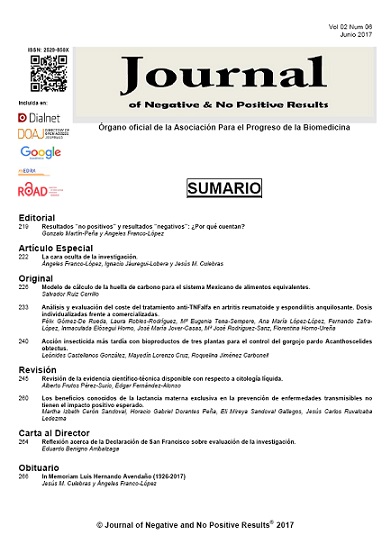Los beneficios conocidos de la lactancia materna exclusiva en la prevención de enfermedades transmisibles no tienen el impacto positivo esperado.
DOI:
https://doi.org/10.19230/jonnpr.1442Palabras clave:
lactancia materna exclusiva, factor de protección, infecciones respiratorias, diarrea, morbilidad, mortalidadResumen
La función de la leche materna es alimentar y proporcionar los nutrimentos esenciales que el lactante necesita para su crecimiento y desarrollo, desde el nacimiento a los primeros meses de vida, debido a esto la Lactancia Materna Exclusiva (LME) es considerada el único alimento indispensable para el recién nacido durante los primeros seis meses de vida.
Objetivo. Determinar el estado del arte respecto a (LME) y su importancia para evitar enfermedades infecciosas en el lactante.
Material y métodos. Se realizó un análisis sistemático y crítico respecto a referencias detectadas en la red, CROSSREF y en PUBMED.
Resultados. La lactancia materna exclusiva LME representa un factor de protección contra enfermedades infecciosas respiratorias y diarrea, es un inductor de maduración inmunológica de la etapa posnatal, activa inmunidad celular y humoral, estimula el desarrollo de actividad enzimática y del sistema óseo del lactante.
Conclusiónes. La LME representa un factor de protección al disminuir la probabilidad de impacto en morbi-mortalidad del lactante y la salud de la madre. El conocimiento que se ha generado al respecto no ha tenido el impacto positivo esperado en la población general. Es necesario proponer como área de oportunidad en los centros de salud estrategias para convencer a la población sobre los beneficios que representa la lactancia materna exclusiva.
Descargas
Citas
NOM. Norma Oficial Mexicana, NOM-043.SSA2-2012 Servicios básicos de salud. Promoción y educación para la salud en materia alimentaria. Criterios para birndar orientación. Diario Oficial de la Federación. (2012).
OMS. Enfermedades infecciosas. Obtenido de http://www.who.int/topics/infectious_diseases/es/. (2016).
NOM. NOM-007-SSA2-2016, Para la atención de la mujer durante el embarazo, parto y puerpeio, y de la persona recién nacida. Diario Oficial de la Federación. (2016).
OMS. Lactancia Materna Exclusiva. (O. M. Salud, Editor, & OMS, (2016). Productor) Obtenido de http://www.who.int/nutrition/topics/exclusive_breastfeeding/es/
Peláez Gutiérrez, R. Enfermedades infecciosas del recién nacido. Obtenido de http://www.bvsde.paho.org/texcom/revperupediatr/rpelaez.pdf (s.f.).
UNICEF. Lactancia materna. Obtenido de Nutrición: https://www.unicef.org/spanish/nutrition/index_24824.html (2015).
Woo, G., Guerrero, M., & Mekibib, A. The DIAMOND (DHA Intake and Measurement of Neural Development) Study: a double-masked, randomized controlled clinical trial of the maturation of infant visual acuity as a function of the dietary level of docosahexaenoico acid. Am J Clin Nutr, 2010. 91: 848-859.
Czank, C., Simmer, K., & Hartmann, P. Design and characterization of a human milk. Breastfeed Med, 2010. 5, 2:59-66.
Chiofalo, B., Dugo, p., & Mondello, L. Comparison of major lipid components in human and donkey milk: new perspectives for a hypoallergenic diet in humans. Immunopharmacol Immunotoxicol, 2011. 33,4: 633-644.
Fernández Brizuela, E., Steward Lemes, G., Alum Bárcenas, J., & Díaz Sobrino, Y. Estado de salud de los niños de 8 a 14 meses según el tipo de lactancia. Revista cubana de Medicina general integral, (2013). 30, 1: 82-92.
ENSANUT, 2012. Consultado en 2017. en INSP, en línea: http://ensanut.insp.mx/
Descargas
Archivos adicionales
Publicado
Número
Sección
Licencia
Todos los originales aceptados quedan como propiedad de JONNPR. Los autores ceden, en el supuesto de publicación, de forma exclusiva los derechos de reproducción, distribución, traducción y comunicación pública (por cualquier medio o soporte sonoro, audiovisual o electrónico) de su trabajo. Para ello se firmará una carta de cesión de derechos en el momento del envío del trabajo a través del sistema online de gestión de manuscritos.
Los artículos publicados en la revista son de libre utilización bajo los términos de la licencia Creative Commons By NC SA, por lo tanto.
Usted es libre de:
Compartir — copiar y redistribuir el material en cualquier medio o formato
Adaptar — remezclar, transformar y construir a partir del material
El autor del copyright no puede revocar estas libertades en tanto usted siga los términos de la licencia
Bajo los siguientes términos:
Atribución — Usted debe dar crédito de manera adecuada, brindar un enlace a la licencia, e indicar si se han realizado cambios. Puede hacerlo en cualquier forma razonable, pero no de forma tal que sugiera que usted o su uso tienen el apoyo de la licenciante.
NoComercial — Usted no puede hacer uso del material con propósitos comerciales.
CompartirIgual — Si remezcla, transforma o crea a partir del material, debe distribuir su contribución bajo la lamisma licencia del original.
No hay restricciones adicionales — No puede aplicar términos legales ni medidas tecnológicas que restrinjan legalmente a otras a hacer cualquier uso permitido por la licencia.

This work is licensed under a Creative Commons Attribution-NonCommercial-ShareAlike 4.0 International License

























